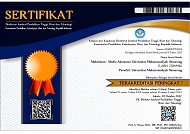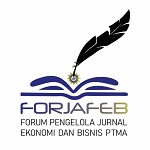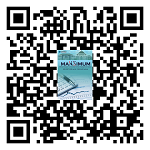Author Guidelines
THIS IS A NEW AUTHOR GUIDELINES, GOING TO BE EFFECTIVE FOR MARCH 2019 ISSUE.
INSTRUCTION FOR AUTHOR
Manuscript Preparation, Writing, and Revision Guidelines
Preparation:
General requirements:
(1) The manuscript should be a study in the field of accounting that is included in MAKSIMUM's focus and scope (see detail).
(2) The manuscript should be original work, i.e. the same manuscript has not been published or accepted for publication in any other journals/ books either in whole or substantial part and must not be submitted to any other journal for concurrent publication or being considered for publication or even being reviewed.
(3) The manuscript is written in English and blind review format, i.e. the manuscript must not attach the author(s)' name(s), institutional affiliation(s), and e-mail address of the author(s) that can identify the manuscript identity as this would against our double-blind review policy. The soft file submitted should be in Microsoft Word format. The manuscript's length, including references and appendices, does not exceed 12,000 words.
(4) The manuscript must comply with the MAKSIMUM author guidelines and be formatted according to the MAKSIMUM template for submission. The manuscript which does not comply with this requirement may be returned for revision (format/template) before entering the review process or might be rejected by the editor.
(5) The manuscript could only be sent via MAKSIMUM's open journal system (OJS) (not by email).
(6) The MAKSIMUM editor reserves the right to edit the grammar and spelling of the text without reducing or changing the intent of the writing.
Writing Guidelines:
The Manuscript is written in the following order:
1. RESEARCH PAPER
Title
Write the title briefly (no more than 15 words is recommended) and clearly. The title should be concise and interesting and describe the content of the article.
ABSTRACT
An abstract is written in English with a single space. The abstract includes a description of the research's purpose, methods, and results. Abstract written in brief, concise, and in one paragraph (around 350 words) that summarizes important research variables, purpose, and methods (e.g., sample and techniques analysis used), as well as the answer to the research problem (result). The abstract contains keywords of ideas or basic concepts in the study fields (no more than 6 words). the abstract should explain the research aims, design/methodology/approach, research findings, and theoretical contribution/originality.
Introduction
This section contains at least the research background, purpose, and contributions, both theoretical and practical. To make a citation, use APA 6th style.
Hypotheses Development (QUANTITATIVE) or Literature Review (QUALITATIVE)
This section contains theoretical underpinning and literature references to previous research related to the topic and also highlights a research gap. The literature referenced is highly recommended to be published no more than ten years ago. Also, it is suggested that the literature be prioritized in the following order: reputable international journals, accredited national journals, national journals, international symposiums, and textbooks.
For research with hypothesis testing, the hypothesis development is built by supporting theory, previous research, and logical argumentation. After the explanation is formulated, then write your hypothesis in the following format:
H1: write the formulated hypothesis.
For qualitative research (without hypothesis testing), the literature review is presented in this section (theory and previous research and argumentation focused on research review). If necessary, the research focus could be written in this part in the question form in the following format:
RM: mention the problem that represents the research focus.
Research Method
This section contains the research design, subject/object/research sample, operational definition, measurement variable, collecting data technique/instrument, and data analysis and hypothesis testing.
Result and Discussion
This section contains the data characteristics of the subject/object/sample/ research respondent, the data analysis result, the testing instrument and hypothesis (if any), the answer to the research question, the findings, and the findings interpretation. This section can be graphed for each research variable if possible. Furthermore, the descriptive statistic value (e.g., Mean, SD, Maximum, Minimum) with its interpretation was presented. The end of the section showed the results of the hypothesis research and a complete discussion of the results.
Conclusion
This section presents the research conclusion, implications, limitations, and advice for future research. The repercussions are practical advice from the results of the research. Research limitations include all aspects that researchers can consider to refine future research, while the research advice is a future direction for the following research based on the limitations highlighted.
Acknowledgement (OPTIONAL)
This section allows the author to express his gratitude to the research funders or the other parties who contribute to the research realization.
Appendix (OPTIONAL)
Contains the research instrument, questionnaires, experiment scenario, interview question list, and other instruments.
References
It contains the sources referred to in the manuscript. Please follow APA 6th style. It is recommended that authors write using citation software such as Mendeley, EndNote, Zotero, etc.
2. LITERATURE REVIEW PAPER
MAKSIMUM accepts a literature review paper with specific requirements:
- Discuss urgent issues and potential research issues to overcome the problems that emerge.
- Provide at least 50 articles from various journals as references.
- Written with robust and critical analysis.
The format of the literature review paper consists of a title, author name(s) and affiliation(s), abstract, introduction, content (including challenges and research opportunity), conclusion, and references.
3. CONCEPTUAL FRAMEWORK PAPER
The format for the conceptual framework paper is the same as the Research Paper. However, it does not provide data analysis.
TABLE AND FIGURE
The table title is numbered and written at the top with a bold font and center, accompanied by the source (if any).
Table 3 Experimental Design and Hypothesis 3a and 3b
The figure title is numbered and written at the bottom of the figure with bold letters and center, accompanied by the source (if any).
Figure 1 Ethical Decision-Making Process
Source: Jones (1991) and Cohen and Bennie (2006)
CITATION
Citations in the text are written between brackets mentioning the author's last name, year by commas, and page number if necessary.
1) One citation resource with one to five authors, the last name of the authors have to be mentioned: one author (Syafruddin, 2001); two authors (Habbe & Hartono, 2000), five authors (Sofyani, Suryanto, Wibowo, Harjanti, & Utami, 2018); more than five authors using et al., for instance: (Boediono et al., 1999); more than one source citation by different authors: (Mardiyah, 2001; Kusumawati, 1999); more than one source citation with the same authors (Djakman, 1998; 2000).
2) If the references consist of the author with more than one article in the same year, the citation used the letters a and b after the year. Example: (Joni, 2014a; 2014b) or (Joni, 2014a; David, 2014b).
3) If the author's name is mentioned in the text, it does not need to be mentioned in the citation in parentheses. The correct example is "Alamsyah (1998) states ...." The incorrect example is "Alamsyah (Alamsyah, 1998) states ...."
4) Citations taken from an institution's work should mention the institution's acronym. For example, Ikatan Akuntan Indonesia or IAI should be (IAI, 2008).
Quote directly and precisely from the referred references (not using a paraphrase) with the same number of lines with more than four lines written slightly indented to the right with a single space (one). Example:
Mulyadi (2011) states:
"Materiality is the value of the omitted or misstated accounting information, as seen from the surrounding circumstances, may result in changes or influence on the consideration of those who put faith in such information, for their omission or misstatement that."
REFERENCES WRITING STYLE
MAKSIMUM bibliography writing style according to APA 6th edition style (available in default form in Mendeley, Endnote, Zotero, etc.). Highly recommended to write a bibliography using the software citation mentioned. To enhance article quality, for further editions, MAKSIMUM does not accept articles containing sources from the thesis or dissertation, working papers, and all articles which have not been published anywhere. Each article should include a bibliography (only the source citation) arranged alphabetically according to the author's last or institution's name. Example:
Book
Bray, J., & Sturman, C. (2001). Bluetooth: Connect without wires. Upper Saddle River. New York: Prentice-Hall.
Forouzan, B.A., & Fegan, S.C.. (2007). Data communications and networking, Fourth edition. New York: McGraw-Hill.
Journal (DOI if any)
With DOI
Coolen-Maturi, T. (2013). Islamic Insurance: Demand and Supply in the UK. International Journal of Islamic and Middle Eastern Finance and Management, 6(2), 87-104. https://doi.org/10.1108/17538391311329806.
Without DOI
Tseng, Y.C., Kuo, S.P., Lee, H.W., & Huang, C.F. (2004). Location tracking in a wireless sensor network by mobile agents and its data fusion strategies. The Computer Journal, 47(4), 448–460. Retrieved from https://ieeexplore.ieee.org/abstract/document/8129953/
A paper published in the proceeding.
Ali, S., Green, P., & Roob, A. (2012). The Influence of Top Managements’ Absorptive Capacity of IT Governance Knowledge on Business-IT Alignment: an Empirical Analysis. The paper was presented at the AMCIS 2012 Proceedings, Australia.
Article in Website
Alexander, J., & Tate, M.A. (2001). Evaluating web resources. Retrieved from Widener
University, Wolfgram Memorial Library. Available at: http://www2.widener.edu/Wolfgram-Memorial-Library/webevaluation/webeval.htm
The University of Portsmouth. http://www.port.ac.uk/library/guides/filetodownload,137568,en.pdf
Rule/Regulation
Kementerian Pendayagunaan Aparatur Negara dan Reformasi Birokrasi. (2012). Surat Edaran Menteri Pendayagunaan Aparatur Negara dan Reformasi Birokrasi Nomor: 08/M.PAN-RB/06/2012 tentang Sistem Penanganan Pengaduan (Whistleblower System) Tindak Pidana Korupsi di Lingkungan Kementerian/Lembaga dan Pemerintah Daerah.
Ministry of Administrative Reform and Bureaucratic Reform. (2012). Minister of Administrative and Bureaucratic Reform Circular Number: 08 / M.PAN-RB / 06/2012 concerning Complaint Handling System (Whistleblower System) Crime Corruption in the Ministry/Institution and Local Government Environment.
FOOTNOTE
Footnotes are only used to provide clarification / additional analysis, which would disrupt the manuscript's continuity when combined into a script. Thus, footnotes should not be used for reference. Footnotes should be numbered and printed superscript. The text of the footnote is typed with 10 font aligned justify.
 MAKSIMUM: Media Akuntansi Universitas Muhammadiyah Semarang is licensed under Creative Commons Attribution Attribution-NonCommercial-NoDerivatives 4.0 International License.
MAKSIMUM: Media Akuntansi Universitas Muhammadiyah Semarang is licensed under Creative Commons Attribution Attribution-NonCommercial-NoDerivatives 4.0 International License.

















